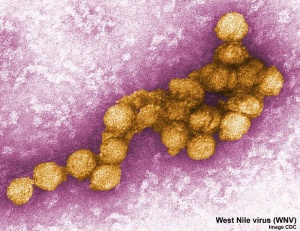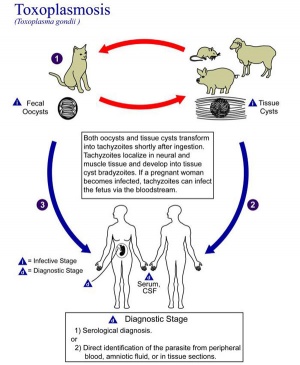Abnormal Development - Zoonotic Infection
| Embryology - 27 Apr 2024 |
|---|
| Google Translate - select your language from the list shown below (this will open a new external page) |
|
العربية | català | 中文 | 中國傳統的 | français | Deutsche | עִברִית | हिंदी | bahasa Indonesia | italiano | 日本語 | 한국어 | မြန်မာ | Pilipino | Polskie | português | ਪੰਜਾਬੀ ਦੇ | Română | русский | Español | Swahili | Svensk | ไทย | Türkçe | اردو | ייִדיש | Tiếng Việt These external translations are automated and may not be accurate. (More? About Translations) |
| Educational Use Only - Embryology is an educational resource for learning concepts in embryological development, no clinical information is provided and content should not be used for any other purpose. |
Introduction
A zoonotic infection (zoonosis) is an animal disease that can be transmitted to humans. This can be through contact with animals (pets, farm animals, wildlife) or their products (milk, meat, waste).
Some Recent Findings
|
| More recent papers |
|---|
|
This table allows an automated computer search of the external PubMed database using the listed "Search term" text link.
More? References | Discussion Page | Journal Searches | 2019 References | 2020 References Search term: Congenital Zoonotic Infection | Zoonotic Infection | Zoonotic Teratogen | Congenital Giardia duodenalis |
| Older papers |
|---|
| These papers originally appeared in the Some Recent Findings table, but as that list grew in length have now been shuffled down to this collapsible table.
See also the Discussion Page for other references listed by year and References on this current page.
|
Potential Zoonotic Infections
|
|
|
|
West Nile Virus

|

West Nile virus (WNV) activity reported to ArboNET, by state, United States, 2012 (as of September 11, 2012) |
- Since 1999, more than 30,000 people in the United States have been reported as getting sick with West Nile virus. Infected mosquitoes spread West Nile virus (WNV) that can cause serious, life altering disease.
- As of September 11, 2012, 48 states have reported West Nile virus infections in people, birds, or mosquitoes. A total of 2,636 cases of West Nile virus disease in people, including 118 deaths, have been reported to CDC. Of these, 1,405 (53%) were classified as neuroinvasive disease (such as meningitis or encephalitis) and 1,231 (47%) were classified as non-neuroinvasive disease.[3]
- Neuroinvasive disease cases - refers to severe cases of disease that affect a person’s nervous system, including encephalitis (inflammation of the brain), meningitis (inflammation of the membrane around the brain) and the spinal cord and acute flaccid paralysis (inflammation of the spinal cord) that can cause a sudden onset of weakness in the limbs and/or breathing muscles.
- Nonneuroinvasive disease cases - refers to typically less severe cases showing no evidence of neuroinvasion, primarily West Nile fever that is a notifiable disease.
(Information CDC)
| West Nile Links: viral infection | zoonotic infection | West Nile Virus | PubMed |
Hepatozoonosis

Hepatozoon is a protozoa with over 300 species acting as obligate intraerythrocytic parasites that infect birds, reptiles, amphibians and mammals, in all continents with tropical and subtropical climates. The dog Hepatozoon canis was first described in the early 1900s.
- Links: Dog Abnormalities
Severe Acute Respiratory Syndrome
Severe acute respiratory syndrome (SARS) - First reported in China in 2002, and later in Asia in 2003, with a mortality rate of approximately 10%. SARS is a coronavirus zoonotic infection with the primary reservoir of bats and the intermediary source was civet cats.
Search PubMed: Abnormal Development Coronavirus | Coronavirus teratogen | SARS Coronavirus teratogen
References
- ↑ Reyes MM, Ailes EC, Daza M, Tong VT, Osorio J, Valencia D, Turca AR, Galang RR, González Duarte M, Ricaldi JN, Anderson KN, Kamal N, Thomas JD, Villanueva J, Burkel VK, Meaney-Delman D, Gilboa SM, Honein MA, Jamieson DJ & Martinez MO. (2020). Zika Virus Detection in Amniotic Fluid and Zika-Associated Birth Defects. Am. J. Obstet. Gynecol. , , . PMID: 31954155 DOI.
- ↑ Borges M, Magalhães Silva T, Brito C, Teixeira N & Roberts CW. (2019). How does toxoplasmosis affect the maternal-foetal immune interface and pregnancy?. Parasite Immunol. , 41, e12606. PMID: 30471137 DOI.
- ↑ 3.0 3.1 Centers for Disease Control and Prevention, National Center for Emerging and Zoonotic Infectious Diseases (NCEZID), Division of Vector-Borne Diseases (DVBD)West Nile information page viewed 11 September, 2012.
- ↑ Suzuki J, Murata R, Kobayashi S, Sadamasu K, Kai A & Takeuchi T. (2011). Risk of human infection with Giardia duodenalis from cats in Japan and genotyping of the isolates to assess the route of infection in cats. Parasitology , 138, 493-500. PMID: 21040620 DOI.
- ↑ Dixon B, Parrington L, Cook A, Pintar K, Pollari F, Kelton D & Farber J. (2011). The potential for zoonotic transmission of Giardia duodenalis and Cryptosporidium spp. from beef and dairy cattle in Ontario, Canada. Vet. Parasitol. , 175, 20-6. PMID: 20971563 DOI.
- ↑ O'Dwyer LH. (2011). Brazilian canine hepatozoonosis. Rev Bras Parasitol Vet , 20, 181-93. PMID: 21961746
Bookshelf
- The Emergence of Zoonotic Diseases: Understanding the Impact on Animal and Human Health: Workshop Summary. Institute of Medicine (US) Forum on Emerging Infections; Burroughs T, Knobler S, Lederberg J, editors. Washington (DC): National Academies Press (US); 2002.
- Bioinformatics in Tropical Disease Research: A Practical and Case-Study Approach Gruber, Arthur; Durham, Alan M.; Huynh, Chuong; del Portillo, Hernando A., editors Bethesda (MD): National Library of Medicine (US), NCBI; 2008
Reviews
Articles
Search PubMed
Search Pubmed: Zoonotic Embryo Infection | Zoonotic Infection
External Links
External Links Notice - The dynamic nature of the internet may mean that some of these listed links may no longer function. If the link no longer works search the web with the link text or name. Links to any external commercial sites are provided for information purposes only and should never be considered an endorsement. UNSW Embryology is provided as an educational resource with no clinical information or commercial affiliation.
- UK Health Protection Report Zoonoses
Glossary Links
- Glossary: A | B | C | D | E | F | G | H | I | J | K | L | M | N | O | P | Q | R | S | T | U | V | W | X | Y | Z | Numbers | Symbols | Term Link
Cite this page: Hill, M.A. (2024, April 27) Embryology Abnormal Development - Zoonotic Infection. Retrieved from https://embryology.med.unsw.edu.au/embryology/index.php/Abnormal_Development_-_Zoonotic_Infection
- © Dr Mark Hill 2024, UNSW Embryology ISBN: 978 0 7334 2609 4 - UNSW CRICOS Provider Code No. 00098G


